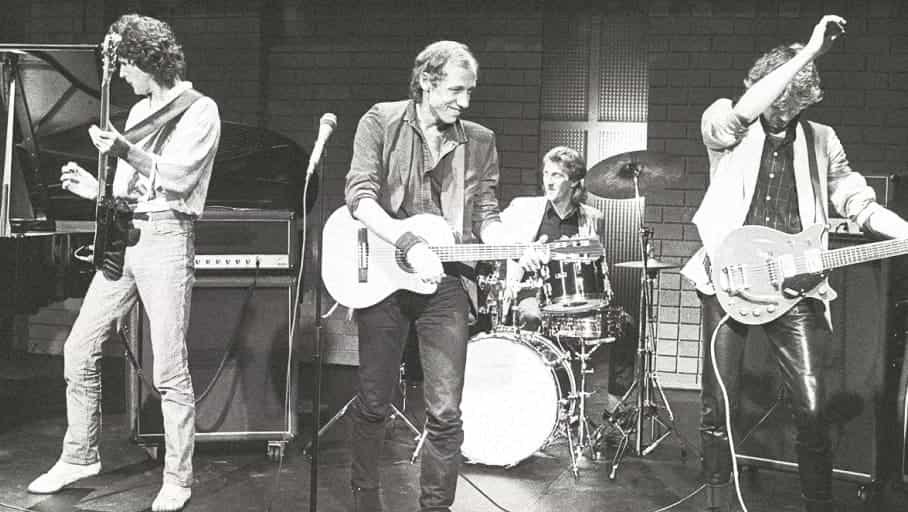In the late 1970s, a distinctive sound emerged from the British rock scene, one that blended the rhythmic stylings of jazz with the raw energy of rock and roll. This sound was pioneered by Dire Straits, a band that would soon become a household name thanks to their breakout hit “Sultans of Swing.” Formed in 1977 by brothers Mark and David Knopfler, John Illsley, and Pick Withers, Dire Straits distinguished themselves with their understated swagger and Mark Knopfler’s intricate guitar work and observational lyrics.
“Sultans of Swing” was first recorded as a demo in 1977, capturing the attention of radio DJs and record labels with its unpretentious yet sharp narrative of musicians living for their music. Officially released in 1978, the song did not immediately chart, but as its airplay spread, it became a sleeper hit, eventually dominating the charts in both the UK and the USA. Its initial reception was one of surprise and admiration; here was a band that eschewed the prevailing punk ethos in favor of polished musicianship and storytelling.
Over four decades later, “Sultans of Swing” has not only established itself as a classic anthem of rock music but also as a seminal piece that underscores Dire Straits’ influence on the music industry. Its enduring appeal lies in its masterful guitar licks and the vivid imagery of bar-band life, securing its place as a timeless piece that continues to resonate with audiences around the world.
The Genesis of “Sultans of Swing”

The story of “Sultans of Swing” begins not in a bustling music studio filled with seasoned producers, but rather in the humble confines of a nearly empty pub in South London. It was here that Mark Knopfler, the lead vocalist and guitarist of Dire Straits, found the inspiration for a song that would become synonymous with the band’s success. Observing a group of aging jazz musicians performing to a sparse audience with undiminished enthusiasm, Knopfler was struck by the poignant contrast between their lackluster surroundings and their passionate performance. This scene provided not just lyrical fodder but also a thematic blueprint for the song’s narrative, celebrating musicians who play purely for the love of music, irrespective of fame or fortune.
Knopfler penned “Sultans of Swing” as a wry, narrative-driven composition that showcased his distinctive finger-picking guitar style, which he deftly blended with a laid-back rock rhythm. The song’s lyrics pay homage to the resilience and modesty of the working musician, themes that resonated widely with audiences and musicians alike. Initially recorded as a demo on a five-track tape in a makeshift studio, the song was marked by its clean guitar sound, devoid of the heavy synthesizers and production gloss that characterized much of the music from the late ’70s.
A Defining Moment
This demo made its way into the hands of BBC Radio London DJ Charlie Gillett, who recognized its potential immediately and played it on his show. The response from listeners was overwhelmingly positive, prompting record labels to take interest. Dire Straits was soon signed to Vertigo Records, and “Sultans of Swing” was re-recorded for their debut album. This version, polished yet still faithful to the raw elegance of the demo, featured an extended guitar outro and Knopfler’s evocative vocals, elements that would help propel the song into the limelight.
Musical Elements

“Sultans of Swing” stands out for its distinctive musical style, which expertly blends elements of jazz and rock while showcasing Mark Knopfler’s unique approach to guitar playing. The song’s structure is fundamentally based on a traditional verse-chorus form, but it is elevated by its intricate guitar lines and rhythmic nuances that lend it a complex yet accessible sound.
Melody and Chord Progressions
The melody of “Sultans of Swing” is memorable for its smooth, flowing lines that mirror the lyrical narrative’s conversational tone. The chord progressions are relatively simple, primarily revolving around D minor, C, and B♭, which provide a jazz-inflected sound that is both laid-back and engaging. The song avoids a predictable pattern by incorporating brief modulations that emphasize the narrative peaks of the lyrics, particularly during the chorus.
Rhythm and Tempo
The rhythm of the song is driven by a steady, swinging tempo that echoes the casual yet precise nature of jazz music. This tempo supports the storytelling style of the lyrics, allowing each word to resonate clearly. The use of a clean, direct drumbeat paired with a rhythmic bass line complements the melodic structure, ensuring that the song maintains a cohesive sound while allowing room for expressive guitar solos.
Mark Knopfler’s Guitar Style
Mark Knopfler’s guitar playing is perhaps the most defining feature of “Sultans of Swing.” His technique involves a fingerpicking style derived from country and folk influences, eschewing the plectrum for a more nuanced touch. This approach allows for a dynamic range of sounds—from soft, subtle notes to sharp, pronounced accents—that enhance the expressive quality of the song. Knopfler’s solos are particularly notable for their clarity and complexity, weaving through scales with a precision that feels both spontaneous and carefully crafted.
Lyrical Narrative
The lyrics of “Sultans of Swing” reflect the lives of musicians who perform in local pubs, playing late into the night with little regard for fame or commercial success. The song’s narrative captures the essence of the music scene it describes, portraying the musicians as unsung heroes dedicated to their craft. Knopfler’s use of vivid imagery and character sketches brings this world to life, offering a glimpse into the understated yet vibrant culture of pub bands. His storytelling is underscored by the music itself, which enhances the atmospheric details and emotional undertones of the lyrics.
Genre Blending and Stylistic Innovations

“Sultans of Swing” emerged during a period dominated by disco and punk, yet it carved out a unique niche by blending elements of jazz, rock, and blues into a seamless musical experience. This genre fusion set Dire Straits apart from their contemporaries, demonstrating their versatility and broad musical appeal.
Blending Jazz, Rock, and Blues
The song’s jazz influences are evident in its swung rhythms and the smooth, melodic lines that mimic the laid-back style of a jazz club performance. The rock elements come through in the song’s structure and the driving beat that underpins Knopfler’s lyrical guitar solos, providing a solid backbone that appeals to rock audiences. Meanwhile, the blues are present in the song’s emotive foundations—the soulful guitar licks and the storytelling lyrics that speak of life’s simpler, more earnest pursuits. This combination not only showcases Dire Straits’ technical skill but also their ability to synthesize diverse musical styles into a coherent and engaging narrative.
Reception by Audiences and Critics
Upon its release, “Sultans of Swing” received widespread acclaim for its refreshing sound and masterful execution. Audiences were captivated by the song’s storytelling approach, which contrasted sharply with the more aggressive and minimalist styles popular at the time. Critics praised the song for its sophistication and subtlety, noting how its sound captured the essence of classic rock and roll with a modern twist. The song’s success on international charts was a testament to its broad appeal, bridging generational and musical divides with its universal themes and innovative sound.
Comparison with Contemporary Songs
When compared to contemporary hits like The Bee Gees’ “Stayin’ Alive” or The Clash’s “White Riot,” “Sultans of Swing” stands out for its understated complexity. Unlike the overt disco beats of “Stayin’ Alive” or the raw energy of “White Riot,” Dire Straits’ hit offered a more introspective and technically refined alternative. It did not rely on electronic enhancements or studio effects, instead relying on the pure quality of instrumentation and lyricism. This not only differentiated it from much of the music of the era but also marked it as a precursor to the more introspective and technically sophisticated rock genres that would emerge in the 1980s.
Production and Sound Engineering

The recording process of “Sultans of Swing” was pivotal in capturing the distinctive sound that would come to define Dire Straits. The approach taken by the band and their production team was meticulous, focusing on clarity and authenticity to preserve the song’s live feel.
Recording Process
“Sultans of Swing” was initially recorded as a demo that caught the attention of record executives due to its clean and unembellished sound. When it came time to record the official track for their debut album, Dire Straits and their producer, Muff Winwood, aimed to replicate the straightforward and engaging quality of the demo while enhancing its sonic aspects. The recording took place at Basing Street Studios in London, known for its state-of-the-art equipment and acoustically engineered rooms, which helped capture the crispness of the instruments.
Production Techniques
One of the key production techniques used in the recording of “Sultans of Swing” was the decision to minimize overdubs and synthetic effects. This choice ensured that the song retained the organic quality of a live performance, a rarity in an era when many recordings were heavily produced. The engineering team focused on microphone placement and mixing techniques that could best capture Mark Knopfler’s fingerpicked guitar solos and the subtle interplay of the drums and bass. Special attention was given to the guitar tones, using a combination of direct input and amplified recordings to create a sound that was both sharp and warm.
Contributions of Band Members and Production Staff
While Mark Knopfler’s guitar work and vocals are the most prominent features of “Sultans of Swing,” the contributions of other band members were crucial in shaping the song’s final sound. John Illsley’s bass playing provided a steady rhythmic foundation that complemented the song’s dynamic swings, while Pick Withers’ drumming added a nuanced yet driving force that enhanced the track’s momentum. The production staff, led by Muff Winwood, played a critical role in ensuring that each element of the song was clearly defined in the mix, from the crisp strumming patterns to the articulate solos that punctuate the track.
The collective effort of Dire Straits and their production team resulted in a track that not only showcased the band’s technical prowess but also highlighted their ability to create music that feels both expansive and intimate. The sound engineering on “Sultans of Swing” set a high standard for recording quality, influencing how music was produced in the subsequent years.
Impact and Legacy

“Sultans of Swing” not only catapulted Dire Straits into the limelight but also left an indelible mark on the music industry. Its release heralded a new era for rock music, characterized by a return to classic instrumentation and storytelling in songwriting.
Elevating Dire Straits to International Fame
The success of “Sultans of Swing” was a defining moment for Dire Straits. Upon its release, the song quickly climbed the charts, reaching the top positions in several countries and earning the band their first gold record. This sudden surge in popularity brought them international acclaim, setting the stage for a career that would include several hit albums and numerous awards. The song’s distinctive sound—a blend of Knopfler’s articulate guitar playing and the band’s tight performance—became their signature, distinguishing them from other acts of the time and garnering a global fanbase.
Influence on Musicians and the Music Industry
“Sultans of Swing” influenced a generation of musicians, who drew inspiration from Knopfler’s unique guitar style and the song’s narrative approach. Guitarists in particular have cited Knopfler’s technique as a major influence on their own playing, admiring his ability to blend simplicity with sophistication. The song’s emphasis on musicianship and lyrical storytelling reinvigorated these aspects within rock music, challenging the then-prevailing trends of punk and disco with its focus on technical skill and narrative depth. Additionally, its production set a benchmark for audio clarity and minimalistic production in recording, impacting how artists and producers approached studio recording sessions.
Closing Thoughts

“Sultans of Swing” is not just a song; it’s a masterclass in storytelling, musicianship, and innovative sound that has left an indelible mark on the landscape of rock music. Dire Straits, led by the quietly commanding presence of Mark Knopfler, crafted a track that defied the musical norms of its time, offering a fresh, jazz-inflected take on rock that resonated with a wide audience.
Contributions to Rock Music and Innovation
The song’s greatest contribution lies in its reintroduction of intricate guitar work and narrative lyricism into the rock genre, which in the late 1970s was saturated with the raw energy of punk and the rhythmic beats of disco. “Sultans of Swing” stood out for its technical prowess and the clean, uncluttered production that focused on the song’s musical strengths—the clarity of Knopfler’s picking technique and the smooth cadence of his storytelling. This was a bold departure from the heavily synthesized and production-heavy sounds that were popular at the time, setting a new standard for what rock music could be.
Cultural Significance and Timeless Appeal
Culturally, “Sultans of Swing” has achieved a timeless status, celebrated not only for its musical mastery but also for its portrayal of the everyman musician. The song’s appeal lies in its relatable subject matter—the unsung local heroes of the music world, whose dedication to their art persists regardless of their audience size or recognition. This narrative resonates on a universal scale, appealing to anyone who appreciates the sheer joy and escape of live music.
A Landmark Recording in Rock History
As we reflect on what makes “Sultans of Swing” a landmark recording, it’s clear that the song encapsulates the essence of rock music’s potential to innovate and inspire. It stands as a testament to Dire Straits’ musical ingenuity and their ability to blend storytelling with sophisticated soundscapes. The song remains a pivotal piece in the band’s legacy and in the history of rock music, continuing to inspire new generations of musicians and fans alike.
